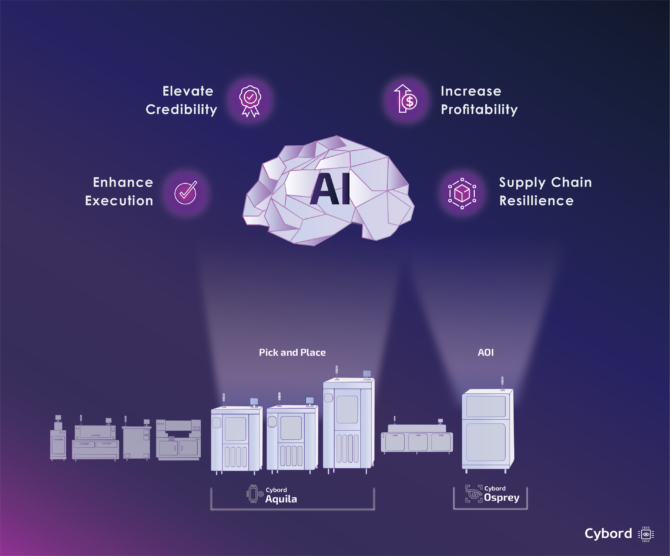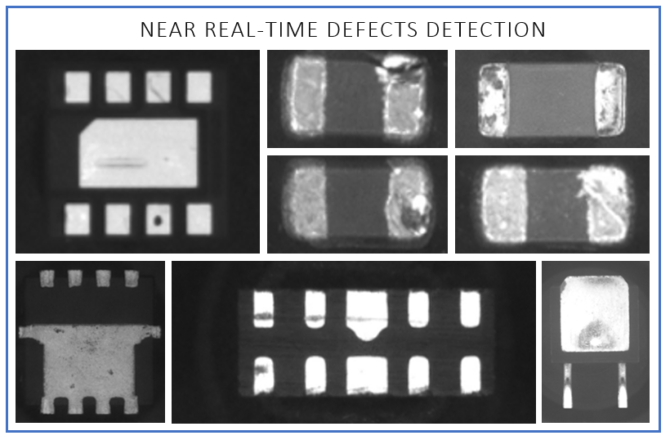
Visual AI platform ensures component reliability
Stephen Law
Automation / Robotics Electronics Engineering Software Engineering IoT AI Cybord distribution platform supply Chain visualProduction floor tool aggregates, analyzes data from 100% of the parts
The success of electronic devices isn’t dependent on how reliant the general public is on them, rather, its success is measured at the very beginning, in the manufacturing stage. When OEMs get faulty products because of defects during the manufacturing stage, a bottleneck effect is created, pushing the problem further along the supply chain, impacting a wider range of people. With defective electrical components making it past this primary stage, and at risk of mounting potential monetary loss, what can OEMs do to ensure trust that they will receive a reliable product?
Cybord, the visual AI platform ensuring the reliability of 100% of electronic components is the quality assurance needed to refine the manufacturing process, ensuring that OEMs will receive reliable and properly documented electronic components. Fueled by big data, the proprietary inspection system analyzes both the top and the bottom of 100% of electrical components in near real time thereby ensuring the reliability of the end-product without slowing down or halting the manufacturing process.
EP&T sits in conversation with Oshri Cohen, CEO of Cybord to discuss the use and application of his firm’s quality assurance measure.
- How disruptive can counterfeit components be when discovered on the production line?
The most disruptive scenario is when defective or counterfeit components are not discovered during the production process and wind up in the final product. In these scenarios, it is often the end user who discovers defects in the product, and ultimately pays the price. With that in mind, uncovering a defective part on the production line is a far more desirable scenario than uncovering a problem when a product is in use – especially for life-dependent products, for example, self-driving cars, health devices, or defense and aerospace technologies.
With advancements in visual AI-based traceability and inspection capabilities, we can detect corroded, or otherwise defective components within the assembly process, empowering manufacturers to identify and eliminate these components efficiently, which in turn boosts productivity and reduces costs by minimizing the scrap and rework rates and providing smooth and efficient product delivery times.
1a. Compare that to when discovered after the end-product has entered the consumer market.
The cost of eliminating products with defective electronic components increases exponentially with each subsequent stage of the manufacturing and distribution process: While the cost is just x$1 at the component level, it rises to x$100 during a product rework, and up to x$1000 when recalling items already in the field. Therefore, when Cybord’s technology is utilized in the assembly stage, we can mitigate the extent of and even eliminate these extremely costly recalls, which result in both financial and reputational damage.
- At what stage of the design cycle does Cybord get involved with OEM or CEM based customers?
The Cybord platform is installed over production lines, therefore analyzing 100% of the components assembled over boards. As such, there is no need to get involved in the design cycle of an OEM. The only setup the system requires is installation of the software over a single server within the production line. Once this installation is completed, all the images taken by P&P and AOI machines are transferred to this server and analysis is performed within a few seconds.

2a. Are there different inventory controls implemented with CEM-based customers at the management level, and operations level?
CEMs follow strict inventory control methods to reduce the risk of getting the wrong parts. However, with all these efforts invested, there is no way to physically see the condition of each and every individual component while it goes to the CEM inventory. Even if the CEMs are able to review every component before it goes to storage, it will not be very useful as they can never know how long the component will be stored and what its condition will be on the day it will be used. The Cybord platform utilizes the assembly stages and performs such component inspection from both the top and bottom component sides a fraction of a second before the component is placed over the board. This way, we overcome the risk of missing any defects developed during the storage period.
- What would you say have been the main issues behind fake part infiltration into the global supply chain?
As we have seen recently, geopolitical events and decisions significantly impact the supply chain and the availability of materials and components we have come to rely on for everyday life. Simultaneously, there is a continuous growing demand for assembled boards across industries like health, defense, and automotive. This growing demand derives from the need to support technological innovations like AI, autonomous electric vehicles, and more. With this rising demand, the fabs capacity to produce legacy products using older tech (silicon based on older then 16nm tech) is not increasing. Most of the new investments are being made to establish new tech fabs so there is a severe shortage of legacy products. This limited supply and rising demand leads to an influx of new suppliers trying to provide a stopgap, and defective parts entering the supply chain and affecting the overall quality of the final products. Supply chain issues are cyclical, and we expect ups and downs and fluctuations. The best and most effective way to tackle the challenge of maintaining component quality amid ‘down’ periods is through utilizing big data and AI. In doing so, we can ensure that whatever components do make their way into the supply chain, whether locally or internationally sourced, they undergo inspection to ensure that they are of the highest quality and can be consumed safely.
- How important is it to have open communication or transparency between different players in the supply chain?
Communication between manufacturers and suppliers is more critical now than ever. Quite often the industry operates on trust; manufacturers obtain components from suppliers they believe are historically trustworthy. Transparency between the manufacturers and the end customers is critical. Such transparent communication and supportive relationships will reduce the chances of end customers experiencing severe shortages and will reduce the need of these end customers to improvise by trying to get their hands on materials from the open market.
- How important is it for OEMs and CEMs to implement quality control measures or adequately enforce those measures at every stage of the production process?
Statistics have shown that approximately 90% of component failures are associated with visual indications on the components themselves. Therefore, it is crucial for OEMs and EMSs to be able to identify those failures, verify that each component is sourced from a reliable source, and ensure that the homogeneity level within the same reel is high, free from any visual defects, oxidation, or mold evidence, at the assembly stage. Catching these defective components early on, increases the productivity of the manufacturing process, ensures reliable end products, and enhances the manufacturers’ bottom lines. Our platform is able to provide complete inspection of 100% of the components that go onto a PCBA (Printed Circuit Board Assembly) and deliver the kind of surgical traceability needed in a zero-trust supply chain environment.

Near-real-time-defects-detection. Source: Cybord
- Are there any design sectors that benefit from increasing quality control over others. (i.e. military, medical, IoT, automotive, etc.)
With the growing ubiquity of chip integration in everyday electronic products, everyone who builds and integrates electronic boards into their products needs such a system. The Cybord platform addresses concerns facing OEMs and EMSs across almost all verticals. We see our system utilized by Tier 1 OEMs, Tier 1 automotive manufacturers, defense contractors, health tech manufacturers, and DataCom companies. In Industry 4.0, visual AI inspection is no longer ‘nice to have,’ but rather a must to serve manufacturers across the board and ensure product quality and reliability through 100% inspection and surgical traceability of electronic components.
- How does Cybord utilize AI and Big Data technology to eliminate electronic component failures?
Relying on AI and big data analytics, Cybord’s solution looks at both the top and bottom of components and analyzes visual data and production metadata from the production line to ensure authenticity, quality, reliability, and visual traceability of all electronic components. Our platform seamlessly connects to component assembly machines, allowing for near real-time inspection of 100% of components a fraction of a second before the assembly process onto the boards is complete. By examining all components within the assembly process, Cybord’s solution empowers customers to identify and eliminate faulty components, which in turn minimizes costly disruptions of the assembly line, reduces the scrap/rework rate of assembled boards, and ensures smooth and efficient product delivery times. The platform works with standard assembly machines, making it compatible with virtually every assembly line in the world.

Cybord CEO Oshri Cohen. Source: Cybord
7a. How does it differ from other inventory methods currently available?
All of the other methods implemented in the industry today sample only a few components from every few reels or trays to verify which are good. Cybord’s solution reviews and analyzes 100% of the components assembled. Other methods require the implementation of new additional machines, which cost a lot and require a re-layout of the production lines and modifications to the production process. The Cybord platform is totally transparent as it is a software-only solution connected to the existing assembly machines over the lines. The software-only Cybord AI platform is installed onto a dedicated server within the factory, which collects all images from existing surface-mount technology machines (SMT) and automated optical inspection (AOI) machines. This development differentiates us from others as it requires no additional capital investments, hardware, or other modifications to production line layouts to deliver quality assurance and chip reliability.
Current production lines that have implemented the Cybord solution provide a surgical traceability level as part of the system output.
- How difficult or disruptive is it to implement these quality assurance practices?
Our technology is a software solution built specifically to integrate with pre-existing SMT and AOI machines, making it a seamless installation. Cybord collaborates with the biggest machine manufacturers in the world to receive component images to add to our database and improve our AI identification system, which does not require any delays or modifications to existing lines. By working directly with the machine manufacturers to feedback the machines with the relevant analysis results, our customers benefit from our technology while using the existing machine interfaces.
